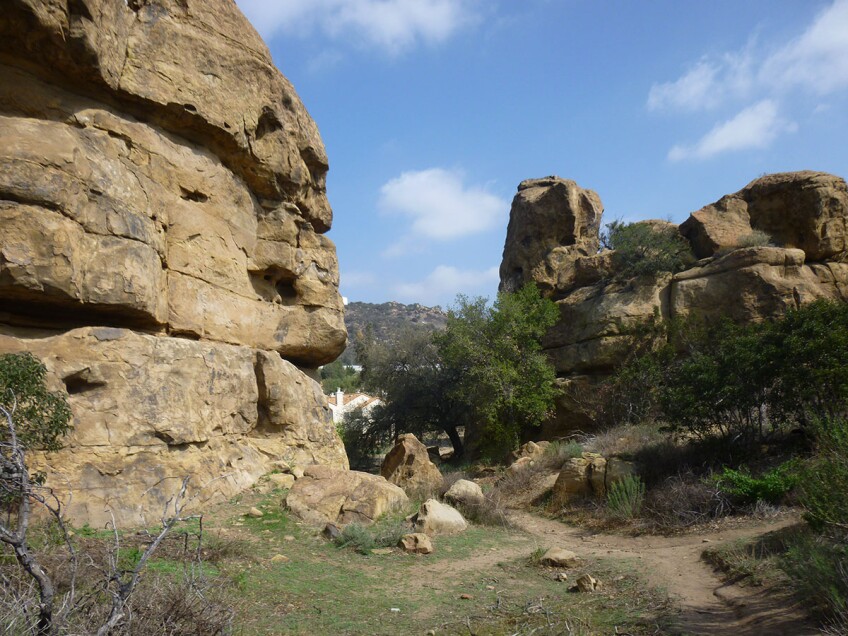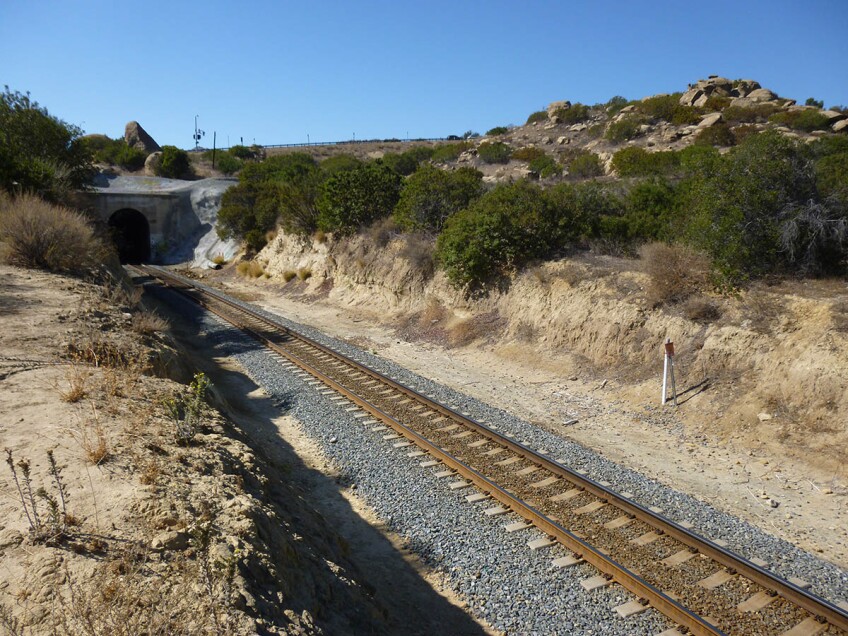Where to Find Chatsworth’s Most Historic Landmarks

Today, you might know it as the bouldered, equestrian-friendly bedroom community in the West San Fernando Valley, but the Los Angeles community of Chatsworth was once a hotbed of Hollywood activity, with movie and T.V. stars galore dotting its craggy hills.
Before that, it was a busy thoroughfare for wagons and stagecoaches heading to and from points up north — a route that’s partially preserved today at Santa Susana Pass State Historic Park.
When it was under the domain of Mission San Fernando Rey de España, Chatsworth was known for its position alongEl Camino de Santa Susana y Simi— a repurposed Native American trail that connected the valley mission with the Mission San Buenaventura and the northward missions and presidios that lie beyond it.
Even today, San Fernando Mission Boulevard runs parallel to Chatsworth Street; and a section of the Old Mission Trail is open to horses and their riders.
But you might pass it all while driving along the 118 or riding the Orange Line, and that would be a shame.
So, here are five great detours that make Chatsworth a worthy destination on its own, thanks to its connections to everything from the Old West to Outer Space.
1. Iverson Movie Ranch at Garden of the Gods
Pretty much anywhere you go in L.A., you'll recognize some scenery or building from a movie or TV show. The whole city — the whole county – is a movie set, and walking or driving through it is like taking a tour of a studio backlot. Sure, there are the actual movie studios in Hollywood, Burbank and Culver City, but there are also all of these dedicated movie ranches once used to depict the Wild West (or, the prairies of Southern Minnesota). Some are still used today, and others have been converted into tourist attractions, parks and open spaces.
One such place is the former Iverson Movie Ranch, a sprawling property in the Valley that flourished during the golden era of Western "B" movies. The whole area is known for its sandstone rock formations, like the famous "Lone Ranger Rock," seen in the opening credits of the TV show. And because of its exotic landscape, stories taking place not only in the Old West – but also Asia, Africa, and the South Seas — have been filmed here. In fact, it may be the "most shot up location in movie history," but also the most shot — having been widely photographed for 50 years.
Part of it — now known as the "Garden of the Gods," acquired by the Santa Monica Mountains Conservancy in 1987 — is a Mountains Recreation and Conservation Authority (MRCA)-managed park open for bouldering and walking. Boulders stand on end, cracked as they balance, some already split right in two. Nature has moved these giant rocks into the most nerve-wracking of positions. The 23-acre park is free to visit and open daily from sunrise to sunset. Park on Redmesa Road.


2. Stoney Point Park
Right off Topanga Canyon Boulevard, shortly after exiting the 118 Freeway, right along the Santa Susana Pass, you happen upon a giant bounder outcropping called Stoney Point. This confluence of boulders — part of an area known geologically as the “Chatsworth Formation,” dating back to the Upper Cretaceous period more than 65.8 million years ago – forms caves, dens, and alcoves for climbing and exploring. Some of those unusual rock formations remain unmolested by graffiti, while others bear markings that you might see on rain rocks, mortars used by native tribes (in this case, the Gabrielino-Tongva tribe). Now a picturesque Los Angeles City Park, dedicated 1982 (with additional acreage added later), there are hiking and bridle trails that can take you around the rocks – but many come to climb on top of them. (Not the least of which was Sylvester Stallone for his 1993 thriller "Cliffhanger.")
For trainspotters, the park provides a good view of the railroad tracks that pass through a tunnel cut out of the rock, Stoney Point being a mile marker for the Southern Pacific Railroad — the train that put the stagecoach out of business.
This tunnel, built in 1904 and renovated with concrete reinforcements in 1921, cuts through the rock under the outcroppings and goes all the way under the Santa Susana Mountains and Pass, marking the division between the Simi Hills and the Santa Susana Mountains, between Los Angeles and Ventura counties.
For decades, the narrow tunnel has served such modern trains as the Metrolink commuter and Union Pacific freight lines (their path also visible from the Santa Susana Pass State Historic Park), their shared single track unfortunately resulting in a disastrous train collision in September 2008, just east of Stoney Point along the curved part of the track. (According to the Los Angeles Times, it was the worst passenger rail disaster in modern California history.) A memorial plaque was dedicated in the park, overlooking the tracks, in 2009.


3. Pioneer Church at Oakwood Memorial Park
Oakwood Memorial Parkhas been used as a cemetery since 1924 — and is now the final resting place for such Hollywood luminaries as Ginger Rogers (buried in the Vale of Memory section), and her RKO movie musical dance partner Fred Astaire (in the Sequoia section — Seeing-Stars.com provides a handy map). But despite its historical value in its own right — located next to the former site of Roy Rogers' former shooting range and beside an old Indian burial ground — it’s most famous for housing Chatsworth’s first landmarked monument, the Pioneer Church, on a rocky knoll at its northwest corner. Funny enough, the house of worship isn’t original to the cemetery.
Volunteer members of the church congregation — including some men who built the Southern Pacific railroad tunnels — originally built it in 1903 at what is now 10051 Topanga Canyon Boulevard. There, it served as a community church as well as, for a time, the community's high school. In 1958, it became the Chatsworth First Methodist Church. And by 1963, the land it was built upon had been sold and one of the last vestiges of “Old Chatsworth” was slated for demolition.
As a result, the Chatsworth Historical Societyformed and managed to save Pioneer Church, which was donated under the condition that it be moved. With the help of donors like Roy Rogers and Dale Evans, Pioneer Church relocated to Oakwood Memorial Park in 1965. Thanks to some finagling of the overhead power lines, the steeple didn’t even have to be removed. Since 1981, St. Mary the Virgin Anglican-Rite Catholic Churchhas occupied it and held services there several times a week. Chatsworth Historical Society also hosts an open house monthly on the first Sunday, from 1:00 p.m. to 4:00 p.m.


4. Chatsworth Historical Society at The Homestead Acre
Once the Chatsworth Historical Society was formed, it needed a home. And what better place than Homestead Acre— a 1.3-acre site within Chatsworth Park Souththat contains the only remaining homestead cottage in the San Fernando Valley? Named to the National Register of Historic Places as the Hill-Palmer Cottage, it’s a Stick-Eastlake style American Craftsman-Bungalow made of redwood — and it’s all that’s left of the original 230 acres homesteaded by James David and Rhonda Jane Hill in 1886 under the 1862 Homestead Act, signed by President Abraham Lincoln.
Although the three-bedroom bungalow is actually the second home to have been built on the site (in 1911), its history is so well preserved, it provides a precious peek into the daily lives of those early pioneers. That’s because the Hills’ daughter, Minnie, lived there for the greater part of her life — from birth to death — and maintained such original features as the kitchen garden, as well as some fruit trees that she added herself. Although she used a Native American leaching basinas a birdbath, this geological and archeological artifact is still very much intact behind the house — once used to remove tannins from acorns to turn them into an edible mush.
Owned by the Los Angeles City Department of Recreation and Parks, Homestead Acre not only houses the Chatsworth Historical Society, but also the Chatsworth Museum(featuring some rail runnel history, circa 1904) and the Frank H. Schepler, Jr. Memorial Library. The historical society offers monthly tours of the cottage on the first Sunday, from 1:00 p.m. to 4:00 p.m. (except holiday weekends). You can also visit on Pioneer Day, an annual fundraiser that will take place this year on Sunday, October 6, 2019 from 11:00 a.m. to 3:00 p.m.


5. F-1 Engine at Aerojet-Rocketdyne
Driving along De Soto Avenue, there’s a roadside attraction that’s worth a double-take: the F-1 engine mounted in front of the offices of Aerojet-Rocketdyne, rising over 19 feet above its visitor parking lot. Originally dedicated on July 20, 1979 — the 10th anniversary of man’s first landing on the moon – it’s the type of Rocketdyne-built engine that helped the Saturn V rocket launch Apollo 11 off the ground (though this one, an Engineering Mockup 1, was never used). Nearly 100 F-1 engines were produced, though only about 65 of them ever experienced space flight.
It was originally mounted in front of the Canoga Park plant responsible for producing the F-1 engines, but it moved three miles away in 2017 from Canoga Avenue to its current location. (Clocking in at 18,400 lbs., that was no easy feat.) Rocketdyne vacated the historic Rocketdyne Propulsion & Power plant in Canoga Park in 2014. It was later razed and has not yet been replaced, despite some talk of a large-scale mall being built in its place on the former Warner Ranch property.
The history of Chatsworth is inextricably linked to Rocketdyne-related rockets and rocket engine testing — not only because of the rocket scientists working in both Chatsworth and Canoga Park, but also the Santa Susana Field Laboratory site that, while located in Ventura County’s Simi Hills, borders the community. The Santa Susana Field Laboratory site is still being decontaminated, so public access is restricted. This rocket display is one of the few things you can see up close and in person that gives any sense of Chatsworth’s role in aerospace history. For more artifacts, visit the Chatsworth Museum at Homestead Acre (above).









